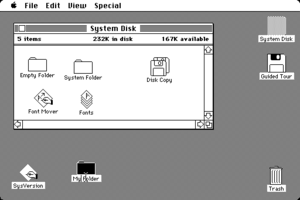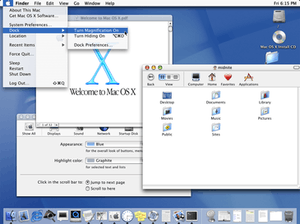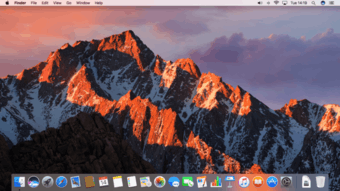Macintosh operating systems

The family of Macintosh operating systems developed by Apple Inc. includes the graphical user interface-based operating systems it has designed for use with its Macintosh series of personal computers since 1984, as well as the related system software it once created for compatible third-party systems.
In 1984, Apple debuted the operating system that is now known as the "Classic" Mac OS with its release of the original Macintosh System Software. The system, rebranded "Mac OS" in 1996, was preinstalled on every Macintosh until 2002 and offered on Macintosh clones for a short time in the 1990s. Noted for its ease of use, it was also criticized for its lack of modern technologies compared to its competitors.[1][2]
The current Mac operating system is macOS, originally named "Mac OS X" until 2012 and then "OS X" until 2016.[3] Developed between 1997 and 2001 after Apple's purchase of NeXT, Mac OS X brought an entirely new architecture based on NeXTSTEP, a Unix system, that eliminated many of the technical challenges that faced the classic Mac OS. The current macOS is preinstalled with every Mac and is updated annually.[4] It is the basis of Apple's current system software for its other devices, iOS, watchOS, and tvOS.[5]
Prior to the introduction of Mac OS X, Apple experimented with several other concepts, releasing different products designed to bring the Macintosh interface or applications to Unix-like systems or vice versa, A/UX, MAE, and MkLinux. Apple's effort to expand upon and develop a replacement for its classic Mac OS in the 1990s led to a few cancelled projects, code named Star Trek, Taligent, and Copland.
Although they have different architectures, the Macintosh operating systems share a common set of GUI principles, including a menu bar across the top of the screen; the Finder shell, featuring a desktop metaphor that represents files and applications using icons and relates concepts like directories and file deletion to real-world objects like folders and a trash can; and overlapping windows for multitasking. The Macintosh is credited with having popularized this concept.[6]
Classic Mac OS

The "classic" Mac OS is the original Macintosh operating system that was introduced in 1984 alongside the first Macintosh and remained in primary use on Macs through 2001.[7][8]
Apple released the original Macintosh on January 24, 1984; its early system software was partially based on the Lisa OS and the Xerox PARC Alto computer, which former Apple CEO Steve Jobs previewed.[7] It was originally named "System Software", or simply "System"; Apple rebranded it as "Mac OS" in 1996 due in part to its Macintosh clone program that ended a year later.[9]
Mac OS is characterized by its monolithic system. It was noted as easy to use and featured cooperative multitasking for most of its history, but it was criticized for its limited memory management, lack of protected memory and access controls, and susceptibility to conflicts among extensions.[2]
Releases
Nine major versions of the classic Mac OS were released. The name "Classic" that now signifies the system as a whole is a reference to a compatibility layer that helped ease the transition to Mac OS X.[10]
- Macintosh System Software – "System 1", released in 1984
- System Software 2, 3, and 4 – released between 1985 and 1987
- System Software 5 – released in 1987
- System Software 6 – released in 1988
- System 7 – released in 1991
- Mac OS 8 – released in 1997
- Mac OS 9 – final major version, released in 1999
Mac OS X/OS X/macOS


macOS (originally named "Mac OS X" until 2012 and then "OS X" until 2016)[11] is the current Mac operating system that officially succeeded the classic Mac OS in 2001.
Although the system was originally marketed as simply "version 10" of Mac OS, it has a history that's largely independent of the classic Mac OS. It is a Unix-based operating system[12][13] built on NeXTSTEP and other technology developed at NeXT from the late 1980s until early 1997, when Apple purchased the company and its CEO Steve Jobs returned to Apple.[14] Precursors to the original release of Mac OS X include OpenStep, Apple's Rhapsody project, and the Mac OS X Public Beta.
macOS makes use of the BSD codebase and the XNU kernel,[15] and its core set of components is based upon Apple's open source Darwin operating system.
Releases
Desktop
The first desktop version of the system was released on March 24, 2001, supporting the Aqua user interface. Since then, several more versions adding newer features and technologies have been released. Since 2011, new releases have been offered on an annual basis.[4]
- Mac OS X 10.0 – code name "Cheetah", released in 2001
- Mac OS X 10.1 – code name "Puma", released in 2001
- Mac OS X 10.2 – also marketed as "Jaguar", released in 2002
- Mac OS X Panther – version 10.3, released in 2003
- Mac OS X Tiger – version 10.4, released in 2005
- Mac OS X Leopard – version 10.5, released in 2007
- Mac OS X Snow Leopard – version 10.6, released in 2009
- Mac OS X Lion – version 10.7, released in 2011
- OS X Mountain Lion – version 10.8, released in 2012
- OS X Mavericks – version 10.9, released in 2013
- OS X Yosemite – version 10.10, released in 2014
- OS X El Capitan – version 10.11, released in 2015
- macOS Sierra – version 10.12, released in 2016
Server
An early server computing version of the system was released in 1999 as a technology preview. It was followed by several more official server-based releases. Server functionality has instead been offered as an add-on for the desktop system since 2011.[16]
- Mac OS X Server 1.0 – code name "Hera", released in 1999
- macOS Server – several releases since 2001
Other projects
Shipped
A/ROSE
The Apple Real-time Operating System Environment (A/ROSE) was a small embedded operating system which ran on the Macintosh Coprocessor Platform, an expansion card for the Macintosh. The idea was to offer a single "overdesigned" hardware platform on which third-party vendors could build practically any product, reducing the otherwise heavy workload of developing a NuBus-based expansion card. The first version of the system was ready for use in February 1988.[17]
A/UX
In 1988, Apple released its first Unix-based OS, A/UX, which was a Unix operating system with the Mac OS look and feel. It was not very competitive for its time, due in part to the crowded Unix market and Macintosh hardware lacking high-end design features present on workstation-class computers. A/UX had most of its success in sales to the U.S. government, where POSIX compliance was a requirement that Mac OS could not meet.[18]
MAE
The Macintosh Application Environment (MAE) was a software package introduced by Apple in 1994 that allowed users of certain Unix-based computer workstations to run Apple Macintosh application software. MAE used the X Window System to emulate a Macintosh Finder-style graphical user interface. The last version, MAE 3.0, was compatible with System 7.5.3. MAE was available for Sun Microsystems SPARCstation and Hewlett-Packard systems. It was discontinued on May 14, 1998.[19]
MkLinux
Announced at the 1996 Worldwide Developers Conference (WWDC), MkLinux is an open source operating system that was started by the OSF Research Institute and Apple in February 1996 to port Linux to the PowerPC platform, and thus Macintosh computers. In the summer of 1998, the community-led MkLinux Developers Association took over development of the operating system. MkLinux is short for "Microkernel Linux," which refers to the project's adaptation of the Linux kernel to run as a server hosted atop the Mach microkernel. MkLinux is based on version 3.0 of Mach.[20]
Cancelled
Star Trek
Star Trek (as in "to boldly go where no Mac has gone before") was a relatively unknown secret prototype beginning in 1992, whose goal was to create a version of the classic Mac OS that would run on Intel-compatible x86 personal computers. In partnership with Apple and with support from Intel, the project was instigated by Novell, which was looking to integrate its DR-DOS with the Mac OS GUI as a mutual response to the monopoly of Microsoft's Windows 3.0 and MS-DOS. A team consisting of four from Apple and four from Novell was able to get the Macintosh Finder and some basic applications such as QuickTime, running smoothly on the x86 architecture. The project was canceled a year later in early 1993, but some of the code was reused later when porting the Mac OS to PowerPC.[21][22]
Taligent
Taligent (a portmanteau of "talent" and "intelligent") was the name of an object-oriented operating system and the company dedicated to producing it. Started as a project within Apple to provide a replacement for the classic Mac OS, it was later spun off into a joint venture with IBM as part of the AIM alliance, with the purpose of building a competing platform to Microsoft Cairo and NeXTSTEP. The development process never worked, and Taligent is often cited as an example of a project death march. Apple pulled out of the project in 1995 before the code had been delivered.[23]
Copland
Copland was a project at Apple to create an updated version of the classic Mac OS. It was to have introduced protected memory, preemptive multitasking and a number of new underlying operating system features, yet still be compatible with existing Mac software. As originally planned, a follow-up release known as "Gershwin" would add multithreading and other advanced features. New features were added more rapidly than they could be completed, and the completion date slipped into the future with no sign of a release. In 1996, Apple decided to cancel the project outright and find a suitable third-party system to replace it. Copland development ended in August 1996, and in December 1996, Apple announced that it was buying NeXT for its NeXTSTEP operating system.[24]
Timeline
 |
Related systems
Before the arrival of the Macintosh in 1984, Apple's history of operating systems began with its Apple II series computers in 1977, which ran Apple DOS, ProDOS, and later GS/OS; the Apple III in 1980, which ran Apple SOS; and the Apple Lisa in 1983, which ran Lisa OS and later MacWorks XL, a Macintosh emulator. Apple also developed the Newton OS for its Newton personal digital assistant from 1993 to 1997.
In recent years, Apple has also launched several new operating systems based on the core of macOS, including iOS in 2007 for its iPhone, iPad, and iPod Touch mobile devices; watchOS in 2015 for the Apple Watch; and tvOS in 2015 for the Apple TV set-top box.
See also
- Comparison of operating systems
- History of the graphical user interface
- Macintosh
- List of Macintosh software
References
- ↑ Gruber, John (January 21, 2009). "Three things OS X could learn from the Classic Mac OS". Macworld. Retrieved September 13, 2016.
- 1 2 Hertzfeld, Andy, folklore.org: The Original Macintosh: Mea Culpa, retrieved 2010-05-10
- ↑ Siracusa, John (March 24, 2006). "Five years of Mac OS X". Ars Technica. Condé Nast Digital. Retrieved April 15, 2009.
Even Steve Jobs still says "ecks" instead of "ten" sometimes.
- 1 2 Gruber, John. "Mountain Lion". Daring Fireball. Retrieved 15 August 2015.
- ↑ Honan, Matthew (January 9, 2007). "Apple unveils iPhone". Macworld. Retrieved January 16, 2010.
- ↑ "Command line tips".
- 1 2 Linzmayer, Owen W. (2004). Apple Confidential 2.0. No Starch Press.
- ↑ "The Macintosh Product Introduction Plan". Stanford University Libraries & Academic Information Resources. Archived from the original on July 21, 2010.
- ↑ Gruman, Galen (November 1997). "Why Apple Pulled the Plug". Macworld. 14 (11). pp. 31–36.
- ↑ "A Brief History of the Classic Mac OS – Low End Mac".
- ↑ "What is an operating system (OS)?". Apple, Inc. 2004-07-15. Archived from the original on July 22, 2010. Retrieved September 6, 2014.
- ↑ "Mac OS X and Unix – Apple" (PDF). Archived from the original (PDF) on May 30, 2009. Retrieved February 5, 2016.
- ↑ "macOS version 10.12 Sierra on Intel-based Mac computers". The Open Group. Retrieved September 29, 2016.
- ↑ Apple Computer (December 20, 1996). "Apple Computer, Inc. Agrees to Acquire NeXT Software Inc.". Retrieved 2007-01-04.
- ↑ "Mac OS X: What is BSD?".
- ↑ "Apple Releases Developer Preview of Mac OS X Lion". Apple. Retrieved February 24, 2011.
- ↑ Inside the Macintosh Coprocessor Platform and A/ROSE
- ↑ Crabb, Don (10 August 1992). "Apple finally gets Unix right with A/UX 3.0". InfoWorld. pp. 68–69.
- ↑ "MAE screenshots". Archived from the original on January 24, 2014. Retrieved March 4, 2015.
- ↑ Barbou des Places, François; Stephen, Nick; Reynolds, Franklin D. (January 12, 1996). "Linux on the OSF Mach3 microkernel". Grenoble and Cambridge: OSF Research Institute. Archived from the original on February 11, 2012. Retrieved April 4, 2013.
- ↑ Hormby, Tom (2005). "Star Trek: Apple's First Mac OS on Intel Project". Retrieved November 10, 2015.
- ↑ Linzmayer, Owen W. (1999). Apple Confidential (PDF). San Francisco, CA: No Starch Press. ISBN 9781886411289. OCLC 245921029. Retrieved March 21, 2013.
- ↑ "Apple surrenders the Pink (to Microsoft)", The Register, 3 October 2008
- ↑ Widman, Jake (October 9, 2008). "Lessons Learned: IT's Biggest Project Failures". PCWorld. Retrieved October 23, 2012.
